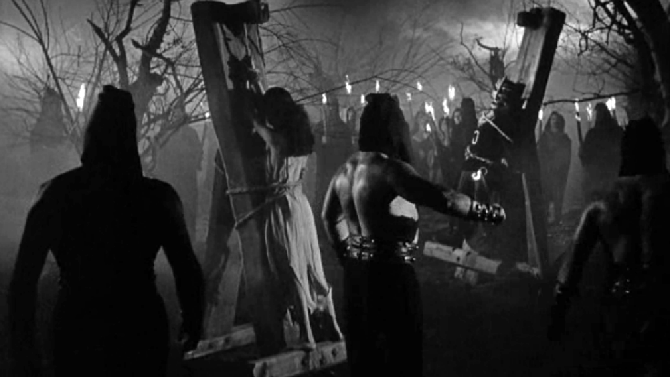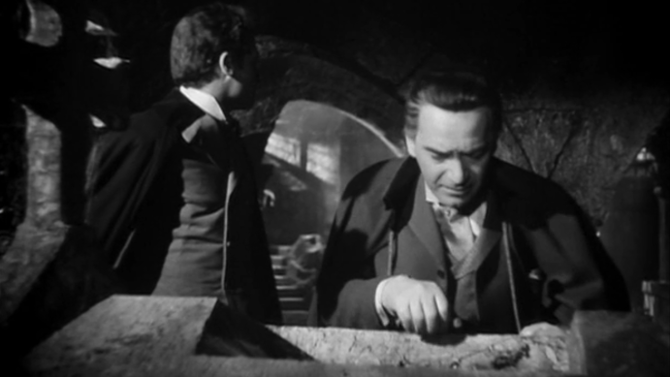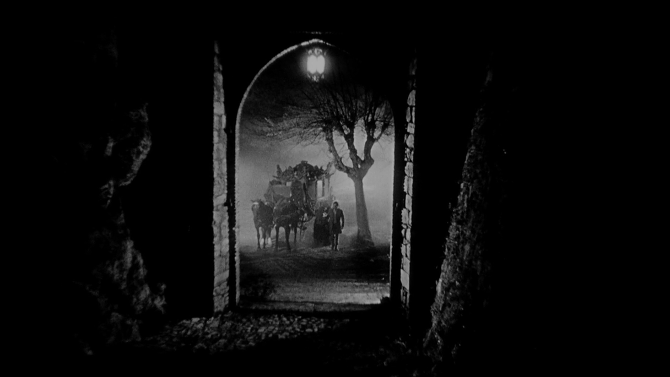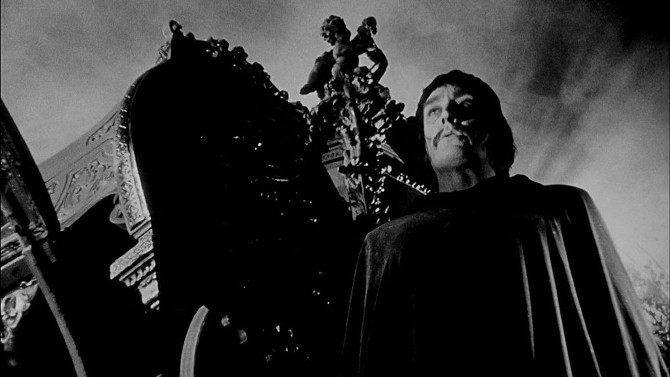Watching Mario Bava’s first credited directorial effort, Black Sunday (1960), is like experiencing those magical Universal monster movies from the 1930s and 40s for the first time. . . with a palpable atmosphere and a rich grounding of very specific lore (that would influence future films for decades to come – much like vampire lore, the crucifix still plays a crucial role), this fantastical tale of witchcraft cannot be easily forgotten.
Opening with the gruesome genesis scene (a sort of flashback to the seventeenth century) that will carry the movie, a stunning witch has been cornered along with her servile lover Igor Javutich (Arturo Dominici). . . the clerics, along with the pitchfork and fire wielding townsfolk, know of only one way to vanquish the evil foe – to first pierce her face with a mask version of an iron maiden and then burn her at the stake. . . but, soon after accomplishing the first task, a rain like no other scatters the horde (as if the storm itself was summoned by Satan), the priests forced to bury the pair separately with a number of safeguards in place.
Flash forward exactly two centuries, and senior doctor Choma Kruvajan (Andrea Checchi) and his young assistant, Dr. Andrej Gorobec (John Richardson), are making their way to a conference by way of horse and carriage. . . falling behind, they insist on taking an overgrown shortcut that locals no longer use – completely ignoring the fearful and paranoid rambling of their driver. . . for it passes right by where the witch was buried.
Pot holed, dark and dreary, the branches scratch at the carriage, while the wind carries the sound of voices – the semblance of those long dead restlessly calling out from their agonizing graves. . . soon, their carriage wheel has fallen off and they find themselves at a destroyed chapel and burial site.
Exploring while waiting for the driver to fix their ride, they discover the location of the supposed witch, the pair gazing upon a most uncanny sight. . . the violent mask is still in its place – seen through a window atop the tomb. . . a large cross placed above it to be constantly seen through the glass.
Whether by unlucky happenstance or some darker and more sinister power, the glass and cross are shattered. . . Dr. Kruvajan cut in the process (his blood dripping on the two century old face).
Thinking nothing of it, the pair depart, startled as they bump into princess Asa Vajda (Barbara Steele) on their way out – an exact doppelganger of the former witch, she is the sister of Prince Vajda (Ivo Garrani), and daughter to the aging (and seemingly haunted) lord of the land, Constantine Vajda (Enrico Olivieri).
It is this event that starts things in motion, a vengeful plot centuries in the planning. For, as the doctors depart, the royal family, in their extravagant stone castle, are haunted that very night. . . their father falling severely ill soon after an extraordinary fright. Sending out a servant to retrieve one of the doctors in the neighbouring town, things are never as they seem, and soon, all of the plot lines are coming back together for the tumultuous finale.
Building off of a wonderful triumvirate of different mind sets, the interconnected triangle is made up of the scientific, reasoned doctors, the supernatural witch and her cohorts, as well as the superstitious rural population (encompassing the royals, local priest and the townsfolk). A solid narrative tactic, each group of people feed off of each other in unique ways, forcing minds to be changed and lives destined for other paths to be altered forevermore. Perhaps the most intriguing is the young doctor, so thirsty to learn and grow in his craft, yet his first encounter with the lovely princess jars his sense and sensibilities – love at first sight. It draws him into this harrowing tale (quick to help and attempt to impress), while still trying to serve his mentor as well as his own sane, logical mind. It is perfectly fitting that the juxtaposition comes from the princess, a doppelganger right out of a gothic horror story (Edgar Allan Poe anyone?) – her beauty, spirit and life force interwoven with the otherworldly energy of the growing ever-more-powerful witch.
Matching the exquisite characters (and acting), Bava develops a visual style that resembles something developed by a seasoned vet, not a first time filmmaker. Understanding the power of the camera, he utilizes slow motion, zoom ins, dramatic pans, first person perspective, fascinating tracking shots, jarring angles (sometimes semi-obscured by forest branches), and a number of other techniques to bring the tension and horror to a boiling point. A perfect example, the opening scene finds the witch about to be pierced by the pointed mask. . . the camera providing an almost first person perspective as it drives us right into it (we can nearly feel every torturous prick touch us), and then, all of a sudden, we pass through it, our gateway to this world now closing in on its target – her visage fully realizing the agony that is coming.
On a different level, Bava also grasps the genius of what to show (and what not to). Often building off of the things that go bump in the night, goose bumps grow as we hear or see things like nails scratching on an unfriendly surface, an eerie whistling, the creaking of a door, the howling of a dog, an uncontrollable wind, a spooky face in the shadows, the unknown fears of a trap door, and the nuance of expertly crafted shadow and light. . . but, when needed, his practical effects are second to none – a face regenerating after two hundred years (the puncture holes still there in all of their gruesomeness), a man removing a mask after the same amount of time, a body rising from the grave, a tomb shattering due to some evil force – together, this visual cadence builds into a truly frightening vibe.
Controversial upon its release (though, at the same time, very successful – putting both Bava and Steele on the map), Black Sunday, which has also been titled The Mask of Satan and Revenge of the Vampire, holds up beautifully all these years later. With both style and substance, intriguing characters and visuals, it is still one of the best witch-related horror films of all-time (its gothic themes perfectly realized). So, enjoy every frame (none of which is skeletal) of this visually stunning film, you’ll feel like you’ve just heard the scariest story ever told round a campfire.





